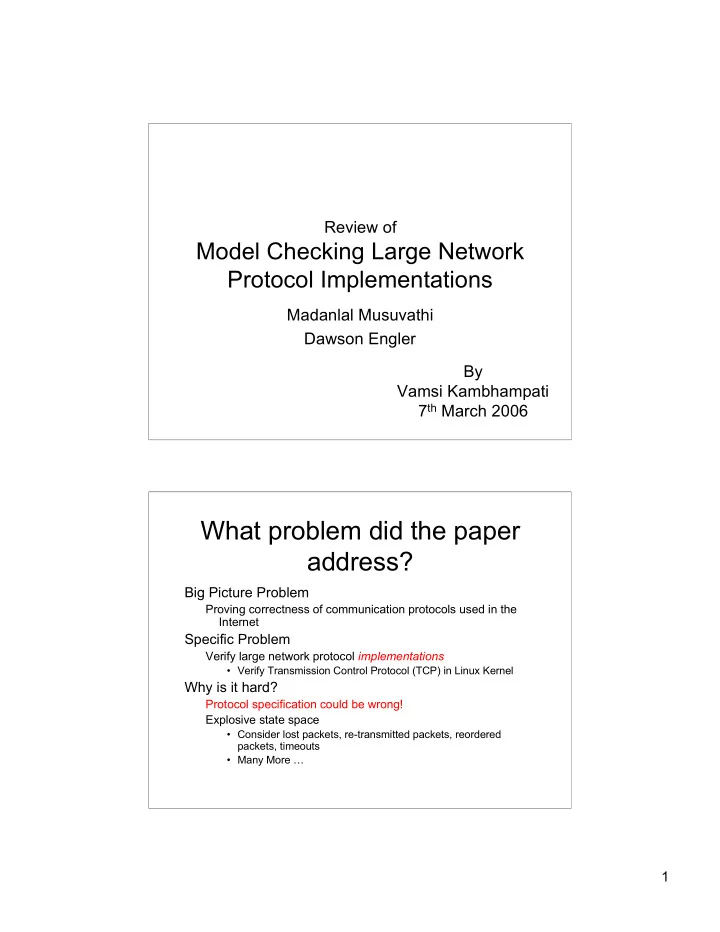

Review of Model Checking Large Network Protocol Implementations Madanlal Musuvathi Dawson Engler By Vamsi Kambhampati 7 th March 2006 What problem did the paper address? Big Picture Problem Proving correctness of communication protocols used in the Internet Specific Problem Verify large network protocol implementations • Verify Transmission Control Protocol (TCP) in Linux Kernel Why is it hard? Protocol specification could be wrong! Explosive state space • Consider lost packets, re-transmitted packets, reordered packets, timeouts • Many More … 1
Why should we care? • Everyone uses the Internet – Online business (e-commerce) – Home computing – Education • Incorrect network protocols are harmful! – Loss of business (money) – Loss of human resources (time) • User expectations: – “Is my network protocol correct?” – “Is my transport protocol inefficient?” – “Is my network protocol implementations vulnerable to attacks?” • Network protocols should be correct Approach: Model Checking • Prove protocol correctness using formal verification techniques – A model of the protocol • Protocol implementation (ex: TCP in Linux) – A set of correctness properties (i.e., the formal specification ) • Expressed as Linear Temporal Logic (LTL) formulas • “Do the correctness properties satisfy for all possible executions of the protocol?” 2
Model Checking Example Process main() { Process inc() { Process dec() { in = 0; while ( in != 0 ) { while ( in != 0 ) { a = 0; skip; skip; concurrent { } } inc(); dec(); if ( in == 0 ) { if ( in == 0 ) { } in = 1; in = 1; } a++; a--; in = 0; in = 0; } } } } • What are the possible values taken by a ? • More specifically, what are the values taken by in ? • LTL formula: [] p , where p is (in == 0 | in == 1), and [] means “always” in LTL grammar This reads, “ at all times in the execution of the program, in is either 0 or 1 ” Is this true for the above program? Model Checking Tool State : The values of variables (globals, locals etc ) at a program point start state (S 0 ) State transition : A possible execution that results in a state change Algorithm: 1. Start from the initial state S 0 state transition 2. Execute a state transition • Generates new states choice point 3. Add new states to queue • Ignore redundant states (using hash) 4. Check if correctness property holds at that point If property does not hold → report error • 5. Enable (one of) unexplored state from queue 6. Repeat from step 2, until No more resources left, or • All states are explored • 3
The C Model Checker • The C Model Checker (CMC) – Backtracking network simulator – Works directly on the implementation of the protocol written in C • Optimized to handle large network protocols – Handles large states • Hash compaction algorithm • Incremental state processing – Handles state space explosion problem • Incremental heap canonicalization • Heuristic based exploration of “interesting” protocol behavior Conclusions • Model checking large network protocols possible with CMC • Linux TCP implementation has 4 bugs! • TCP specification is ambiguous • CMC achieves large protocol coverage (92% combined coverage for Linux TCP implementation) 4
Critique • Probably the first attempt to model check TCP • Results are impressive, – 4 bugs in Linux TCP – 92% protocol coverage • Assumes the user is aware of a lot of background in model checking • Should have specified at least a few correctness properties for TCP • Does not demonstrate the effort needed to model check a protocol Relation to CS653 • I care – Our project is all about model checking network protocols • Model checking is a form of program analysis (for debugging programs) • Demonstrates program analysis for nondeterministic systems – So far we looked at static program analysis for deterministic systems 5
Recommend
More recommend